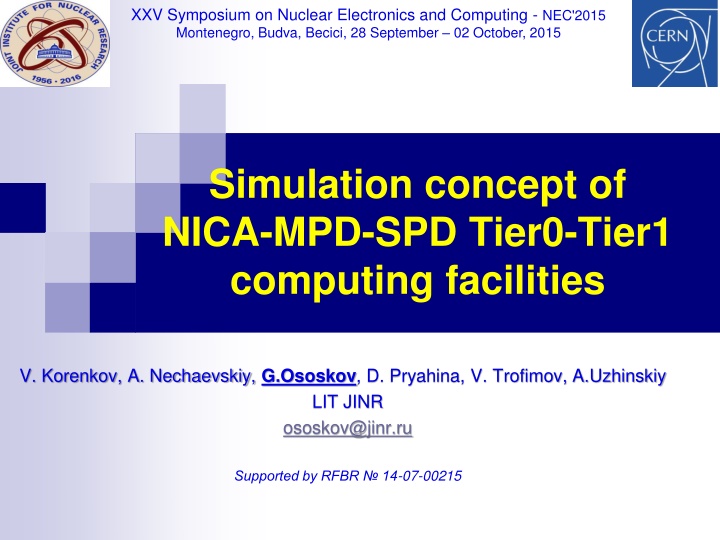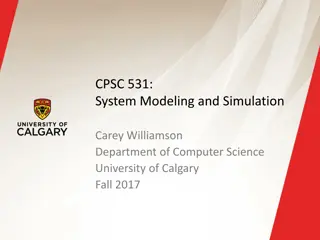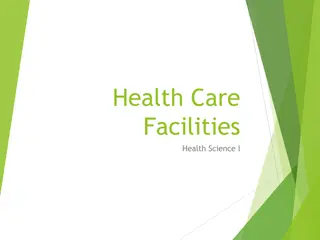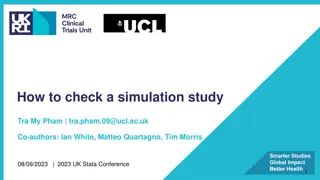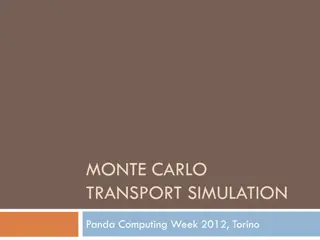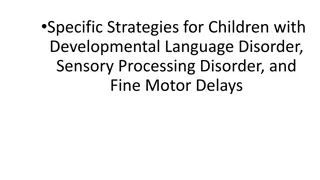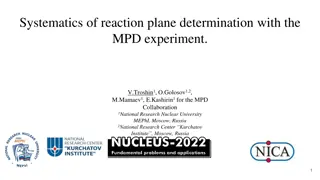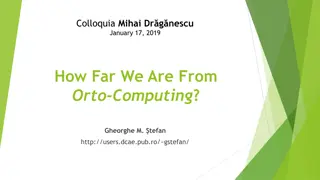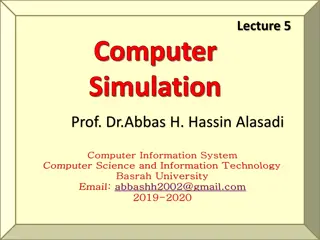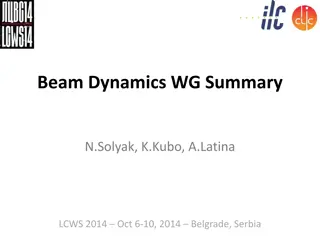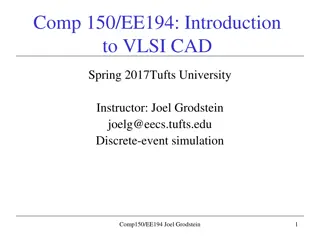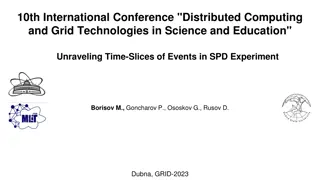Simulation Concept of NICA-MPD-SPD Tier0-Tier1 Computing Facilities
New computing challenges for Big Data scale at the NICA megaproject involving distributed computing, grid-cloud systems, and dynamic data placement. Optimality study crucial for grid-cloud system design and development, emphasizing equipment cost minimization and SLA fulfillment through efficient simulations of computing resources and job streams.
Download Presentation

Please find below an Image/Link to download the presentation.
The content on the website is provided AS IS for your information and personal use only. It may not be sold, licensed, or shared on other websites without obtaining consent from the author.If you encounter any issues during the download, it is possible that the publisher has removed the file from their server.
You are allowed to download the files provided on this website for personal or commercial use, subject to the condition that they are used lawfully. All files are the property of their respective owners.
The content on the website is provided AS IS for your information and personal use only. It may not be sold, licensed, or shared on other websites without obtaining consent from the author.
E N D
Presentation Transcript
XXV Symposium on Nuclear Electronics and Computing - NEC'2015 Montenegro, Budva, Becici, 28 September 02 October, 2015 Simulation concept of NICA-MPD-SPD Tier0-Tier1 computing facilities V. Korenkov, A. Nechaevskiy, G.Ososkov, D. Pryahina, V. Trofimov, A.Uzhinskiy LIT JINR ososkov@jinr.ru Supported by RFBR 14-07-00215
NICA-MPD-SPD General view of the NICA complex with the collider experiment MPD and experiments MPD, SPD, BM@N 1 G.Ososkov NEC'15 Montenegro-Budva 28 sep -2 oct 2015 2/24/2025
New computing challenges for Big Data scale Potentially new physics is expected at the LHC 2nd run and the new JINR NICA megaproject Working at TB scale the MPD-SPD experiments will face with great challenges in distributed computing: large increase of CPU and network resources; combined grid and cloud access; Intelligent dynamic data placement distributed parallel computing; renewal most of simulation and analysis software codes. These problems are inherent to such the JINR projects as the running Tier 1 for CMS and the planning Tier 0/1 for NICA Currying out such unique projects supposes great efforts for the design and development of sophisticate grid-cloud systems intended to store, distribute, and process super-big volumes of experimental data 2 G.Ososkov NEC'15 Montenegro-Budva 28 sep -2 oct 2015 2 2/24/2025
Simulation of grid-cloud systems Substantial optimality study is needed to avoid possible and quite expensive mistakes on design and development stages of any grid-cloud system The study of grid-cloud system optimality is based on the optimality criterion which minimizes the equipment set (cost) under unconditional fulfilment of SLA (Service Level Agreement) Such studies can be efficient when it is based on scrupulous simulations of computing resources (number of compute nodes, the architecture of a computer system, installed software, CPU consumption) Data flow Job stream with knowledge of Job types (simulation, analysis, reconstruction) Statistical information about distribution of their arrival and execution times Efficient simulation of grid-cloud systems should take into account the functioning quality of this system to evaluate its performance and to forecast its future taking into account dynamics of its evolution. 3 G.Ososkov NEC'15 Montenegro-Budva 28 sep -2 oct 2015 3 2/24/2025
Basic simulation concepts The best way to evaluate dynamically the system functioning quality is using its monitoring tools The simulation program is to be combined with real monitoring system of the grid/cloud service through a special database (SDB) Toensure a developer from writing the simulation program from zero on each development stage it is more feasible to accept a twofold model structure, when it consists from 1. a core its stable main part independent on simulated object and 2. a declarative module for input of model parameters defining a concrete distributed computing center, - its setup and parameters obtained from monitoring information, as dataflow, job stream, etc SDB intention is just to realize this declarative module work and provide means for output of simulation results Web-portal is needed to communicate with SDB assigning concrete simulation parameters and storing results in SDB 4 G.Ososkov NEC'15 Montenegro-Budva 28 sep -2 oct 2015 2/24/2025
What simulations should give us on the design stage of a grid-cloud system Evaluate grid-cloud system performance and reserves under various changes: Different workloads System configuration Different scheduling heuristics Hardware malfunctions Balance the equipment needed for data transfers and storage by minimizing cost, malfunction risk and execution time; Optimize resource distribution between user groups; Predict and prevent a number of unexpected situations Test the system functioning to find bottlenecks. 5 G.Ososkov NEC'15 Montenegro-Budva 28 sep -2 oct 2015 5 2/24/2025
How it was realized Our team has already the experience with simulation grid structures inspired by GridSim library (http://www.buyya.com/gridsim) and job scheduler ALEA (http://www.fi.muni.cz/~xklusac/alea). The new simulation program called SyMSim (Synthesis of Monitoring and SIMulation) wasdeveloped according to the above basic concepts and succesfully tested for the JINR CMS Tier 1 center with robotized tape library. To accomplish that 1. New classes are invented to declare the data store specific for the tape robot library; 2. Input job stream is formed via data base; 3. Data exchange process is modified from packet flow simulation into file transfer simulation; 4. Software means for handling simulation results are provided. G.Ososkov NEC'15 Montenegro-Budva 28 sep -2 oct 2015 6 2/24/2025
Tier1 Dataflow simulation The problem is to simulate a data storage system with robotized tape library, where RAW data are to be transferred from disks of a great HEP experiment. In reality we were charged to design such data storages for the CMS Tier 1 at JINR. Tape robot IBM 3500 JINR T1 ss How it works on T1 site: 1. From disk to tape: - If slot and file are available, job is executed at the farm; 2. From tape to disk: - If file stored in tape library. job reserves a slot, but is waiting for necessary file on the disk: the robot moves tape cartridge to the drive, cartridge's file system mounting to the drive, file is copied to the disk. 7 Site 0 at CERN Scheme of the job and data flow at JINR 1 G.Ososkov NEC'15 Montenegro-Budva 28 sep -2 oct 2015 2/24/2025
SyMSim working scheme for the CMS Tier 1 at JINR Real Grid/Cloud 1. Jobs are submitted to the Workload Management System from different sources 2. Jobs are submitted to the Sites 3. Information about execution and queues are passed to the monitoring system Simulation 4. Statistics data accumulated from T1 are used to generate simulation workflow 5. SimulatedJob stream is submitted to the model 6. Researcher gets results from model and analyzes them 7. Researcher modifies the workflow parameters 8. Researcher initializes procedure of the site configuration changes 9. New simulation cycle starts SyMSim working scheme for the CMS Tier 1 at JINR with robotized tape library 8 G.Ososkov NEC'15 Montenegro-Budva 28 sep -2 oct 2015 2/24/2025
Our simplifications Hardware of T1 computing center is fail-proof Each job is used the only file Raw files are removed from disks after writing on tape FIFO queue to execute There is not yet multi-threading Job stream is stationary Sequence of computing experiment Specify the model parameters - the number of jobs and their arrival rate Load the description of hardware architecture Generate dataflow and workflow Run simulation Analyse results 9 G.Ososkov NEC'15 Montenegro-Budva 28 sep -2 oct 2015 9 2/24/2025
Model verification by comparing JINR Tier 1 real and simulated characteristics CPU - 2400 Disks - 2400 TB these parameters from real T1 were set to the model Tapes - 5 PB Statistics was taken from ~ 2 mil. Submitted Jobs (2014) ~ 3 mil. Submitted Jobs (6 month of 2015) 10 G.Ososkov NEC'15 Montenegro-Budva 28 sep -2 oct 2015 2/24/2025
Real and Generated Workflow (CMS T1 JINR) Completed jobs (simulated) Completed jobs (real) 40000 30000 20000 10000 0 X = 24000 S = 6100 X = 19700 S = 6700 WallClock HEPSPEC06 (real) WallClock HEPSPEC06 (simulated) 40000 35000 30000 25000 20000 15000 10000 5000 0 20/05/2015 27/05/2015 03/06/2015 10/06/2015 17/06/2015 X = 22000 S = 6400 X = 21300 S = 8100 These two examples among some others were used for the positive validation of the running CMS T1 model and encouraged us to simulate the more sophisticate and planning yet the T0/T1 system of NICA project. 11 2/24/2025 G.Ososkov NEC'15 Montenegro-Budva 28 sep -2 oct 2015
Simulation evolution: from CMS Tier1 to NICA Tier0-Tier1 Tier 0 module denotes the center of data gathering from the experiment (either MPD or SPD). Obtained raw data are to be stored on disks. One of planned problems is to recommend the volume of the disk store and a temp of data transfer to the robotized library which is the part of Tier 1 center. This two-level structure is interconnected by a local area network DQ on this scheme denotes not only DAQ of the corresponding experiment, but includes also the means of communications and buffer cleaning. (AN). Data storage and processing scheme of Tier0-Tier1 level Initial information to start simulation are parameters of setup of designed hardware data flow, job stream their characteristics are taken from Real data of CMS Tier1 monitoring and TDR DAQ PD 12 G.Ososkov NEC'15 Montenegro-Budva 28 sep -2 oct 2015 2/24/2025
Reminder: The simulation program is to be combined with a real monitoring system through a special database (SDB), which intention is just to input of model parameters and output of simulation results Web-portal is needed to communicate with SDB assigning concrete simulation parameters and storing results in SDB Simulation of T0/T1 1 Database design Database contains the description of the grid structure, each of its nodes, links between nodes, running jobs information, execution time, the monitoring results of the various subsystems of the grid and the simulation results. Database main tables Experiments contains information about the experiments; Simulation_Parameters describes starts (runs) simulation program; Configurations contains a description of the simulation configuration; Jobswaiting contains a description of a job flow (the model of input data); Results program results. Details are expounded in Dasha Pryahina talk on Student School Four types of jobs are generated 1. Data acquisition (DQ) simulated raw data to be stored 2. Monte-Carlo (MC) do not need input data 3. Express analysis (EA) jobs use recently obtained files 4. Reconstruction processing (PR) jobs consume the most of resources 13 G.Ososkov NEC'15 Montenegro-Budva 28 sep -2 oct 2015 2/24/2025
Simulation of T0/T1 2 Web-portal functions Interaction with the database. Current model structure and generated workflow description. New workflow with different parameters (number of DQ, MC, EA, PR jobs) generation. Simulation results representation (graphics, diagrams). Snapshot of SyMSim web-portalt Simulation algorithm is designed that at the initial time all buffers are empty, the processor is not loaded and data are not transferred. Therefore the initial transition process must be excluded from the analysis. It also happens when the current job flow stops. The result of the simulation program is a sequence of records in the database, which reflects all the events occurring at the system. 14 G.Ososkov NEC'15 Montenegro-Budva 28 sep -2 oct 2015 2/24/2025
Examples of simulation results 1 Example 1 Estimated rate of NICA-MPD project experimental data to be transferred to Tier 1 data center is about 24 PB by one month of the MPD detector work Simulation result shows what happened in the grid/cloud system if the data volumes are grow up to 1,5 times for example. This simulation result allows one to understand how the intensity of the input stream determines the reserves of the system capacity Fig.1 Number of DAQ data files stored on output disk buffer for growing data volumes 15 G.Ososkov NEC'15 Montenegro-Budva 28 sep -2 oct 2015 2/24/2025
Examples of simulation results 2 Example 2 What buffer size is needed to store input files on tapes without losses Zigzag shape of this curve is due to regular buffer cleaning. The sharp slump in the middle is caused by end-of- tape delay TB t=system time Fig.2. Disk available space (in terabytes) Results in fig.1-2 show that due to clever buffer cleaning the buffer should not be too big, so we can place it in RAM operational memory 16 G.Ososkov NEC'15 Montenegro-Budva 28 sep -2 oct 2015 2/24/2025
Examples of simulation results 3 Example 3 Probability of the system overloading due to disk space lack Fig.3. the load in MB/sec from one of network nodes to a disk 17 G.Ososkov NEC'15 Montenegro-Budva 28 sep -2 oct 2015 17 2/24/2025
Conclusions The program SyMSim for simulation of grid-cloud structures is developed and tested on a simplified model of JINR Tier1 site. The originality of proposed simulation approach consists in combining a simulation program with a real monitoring system of the grid/cloud service through a special database in frame of the same program. The next simulation was accomplished for T0/T1 computing facilities of JINR NICA MPD-SPD project. It confirms good potential of our simulation approach, but also showed some of its incompletenesses needed to be retreated. SyMSim structure is sufficiently general and flexible to allow to replace our present simplifications into more developments. It can also be used to solve design problems and the subsequent development of data repositories, not limited to the physical experiments area. 1. 2. 3. 4. real conditions in future 5. 18 G.Ososkov NEC'15 Montenegro-Budva 28 sep -2 oct 2015 2/24/2025
Some references Synthesis of the simulation and monitoring processes for the development of big data storage and processing facilities in physical experiments // Computer Research and Modeling, T7, 3, 2015 Grid and cloud services simulation as an important step of their development // Systems and Means of Informatics, Volume 25, Issue 1, 2015 Site: symsim.jinr.ru E-mail: symsim@jinr.ru 1. 2. 3. 4. 19 G.Ososkov NEC'15 Montenegro-Budva 28 sep -2 oct 2015 19 2/24/2025
Thank you for the attention! symsim.jinr.ru symsim@jinr.ru 20 G.Ososkov NEC'15 Montenegro-Budva 28 sep -2 oct 2015 20 2/24/2025
